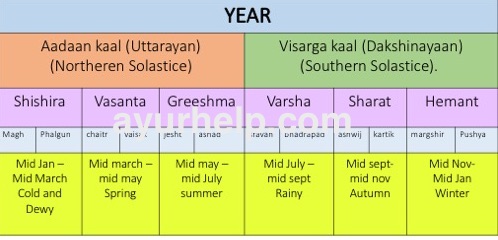Ayurveda emphasizes on prevention of diseases. Following a regular seasonal routine or rutucharya through food and lifestyles help to increase immunity, strength, and stamina.
The 6 Rutus or Ayurvedic Seasons are
- Shishira rutucharya – A healthy lifestyle for cold and dry weather
- Vasanta
- Greeshma
- Varsha rutu (Ayurveda Care During Monsoon- Varsha Rutucharya)
- Sharad
- Hemantha Rutucharya – Seasonal Regimen for winter
Table of content
Difference between Aadaana kala( Uttarayana) and Visarga kala (Dakshinayana)
A bird’s-eye view of Diet according to Season
Vata season, pitta season and kapha season
Introduction to Rutucharya
The seasons are known as ritu in Ayurveda. Ayurveda acharyas explain the importance of following seasonal routines or ritucharya in order to keep up our health. Following these routines help to boost immunity and keep diseases at bay. Following ritucharya increases life span, strength, and Energy
Ayurveda acharyas divide a year into two kalas or Solstice, based on the position of the sun. They are
- Aadaana kaala or Uttarayana or Northern Solastice
- Visarga Kaala or Dakshinaayana or Southern Solastice
Difference between Aadaana kala( Uttarayana) and Visarga kala (Dakshinayana)
Aadaana kala( Uttarayana):
Aadaana means taking away or capture. During adana kala sun and wind are very powerful. They are fiery in nature and dry the moisture from the earth and living beings. Because of this earth loses its cooling properties and people become very weak and debilitated.
Visarga kala (Dakshinayana)
Visarga means sending forth or release. During this period moon is very powerful and sun is not so strong. This along with clouds, rains, and the cold wind cools the earth. Thus sun starts giving energy to the earth. All living beings including humans become healthy and strong in visarga kala.
Ritus or Ayurvedic Seasons :
A year is divided into 6 ritus or seasons. It is explained in Ayurveda as follows

6 Rutus are
- Shishira
- Vasanta
- Greeshma
- Varsha
- Sharad
- Hemantha
These ritus or seasons are distributed between adaana kala and visarga kala. Each kala contains 3 ritus. Shishira, Vasanta, Greeshma are included in adaana kala. Varsha, Sharad, and Hemanta are included in visarga kala.
Each ritu is comprised of masa or months.
- Shishira ritu which extends from mid-January to mid-march is a cold and dewy season. It contains months or masa Magh and phalgun.
- Vasanta ritu which extends from mid-March to mid-May denotes spring. It contains months or masa Chaitra and Vaishakha.
- Greeshma ritu which extends from mid-May to mid-July is summer. It contains months or masa Jeshta and Ashada.
- Varsha ritu which extends from mid-July to mid-September is the rainy season It contains months or masa Sravana and Bhadrapada.
- Sharad ritu which extends from mid-September to mid-November is autumn season. It contains months or masa Ashwija and kartika.
- Hemanta ritu which extends from mid-November to mid-January is the winter season. It contains months or masa Margashira and Pushya.
A bird’s-eye view of Diet according to Season
The 6 tastes or Shad rasa or 6 rasa of foods change according to ritus or seasons. It is very important to add these foods to the seasonal diet.
Shishira ritu :
In this season bitter taste or tikta rasa is very prominent and this has to be added to diet.
Vasanta Ritu:
Kashaya rasa or astringent taste is very powerful in this spring season.
Greeshma ritu:
In greeshma ritu katu rasa or pungent taste is very prominent.
Varsha ritu
In rainy season amla rasa or sour taste is very prominent and this has to be added in diet.
Sharat ritu
Salty taste or lavana rasa prevails during this season. Salt like Sendha namak or rock salt has to be included in the diet wherever possible.
Hemant Ritu
During hemanta ritu, sweet taste or madhura rasa is very prominent.
The following table helps to remember these very easily
Prevalence of Doshas according to seasons: (Vata season, pitta season, and Kapha season)
Seasons affect tridosha. The dosha proportion varies according to seasons.
Vata dosha season or vata season
Vata dosha Accumulates in summer when the season is dry and dehydrating. It aggravates during the rainy season. This aggravation weakens Agni or digestion power and causes an acidic environment in the body. Even the surrounding environment will be acidic due to fiery weather.
Pitta Dosha season or pitta season
Pitta dosha accumulates during the rainy season due to acidic conditions caused by Vata and weak Agni. Pitta aggravates in autumn when heat is increased due to humidity after rains.
Pitta gets exaggerated in summer. When pitta is off balance you will witness flaring up of acne, skin rashes, acidity, heartburn, low blood sugar, and sleeplessness or Insomnia. All these lead to irritability, impatience, and anger.
To balance pitta avoid foods that are spicy, sour, salty, hot, and dry. Keep hot coffee, salty chips, and spicy fast foods at bay. For Sleeplessness, you can follow Ayurvedic Remedies, Medicines, and Tips for Good Sleep
Kapha Dosha Season or Kapha season
Kapha dosha accumulates during winter due to the dampness of rain and cold wind. It gets aggravated during spring when the warm sun liquifies accumulated Kapha. Cool-weather and not-so-bright environments affect our body and mind in the same way. Heavy and sticky toxins accumulate in the body and reduce immunity. Because of this allergies, cold, fatigue, and digestive disorders may surface. You can boost immunity through Ayurveda foods and herbs.
Consult Dr.Savitha Suri for ayurvedic remedies. Email drsavithasuri@gmail.com . WhatsApp + 91 6360108663
Author : Dr. Savitha Suri Consultant Ayurvedic Physician
Call us at +91 9945995660 / +91 9448433911







